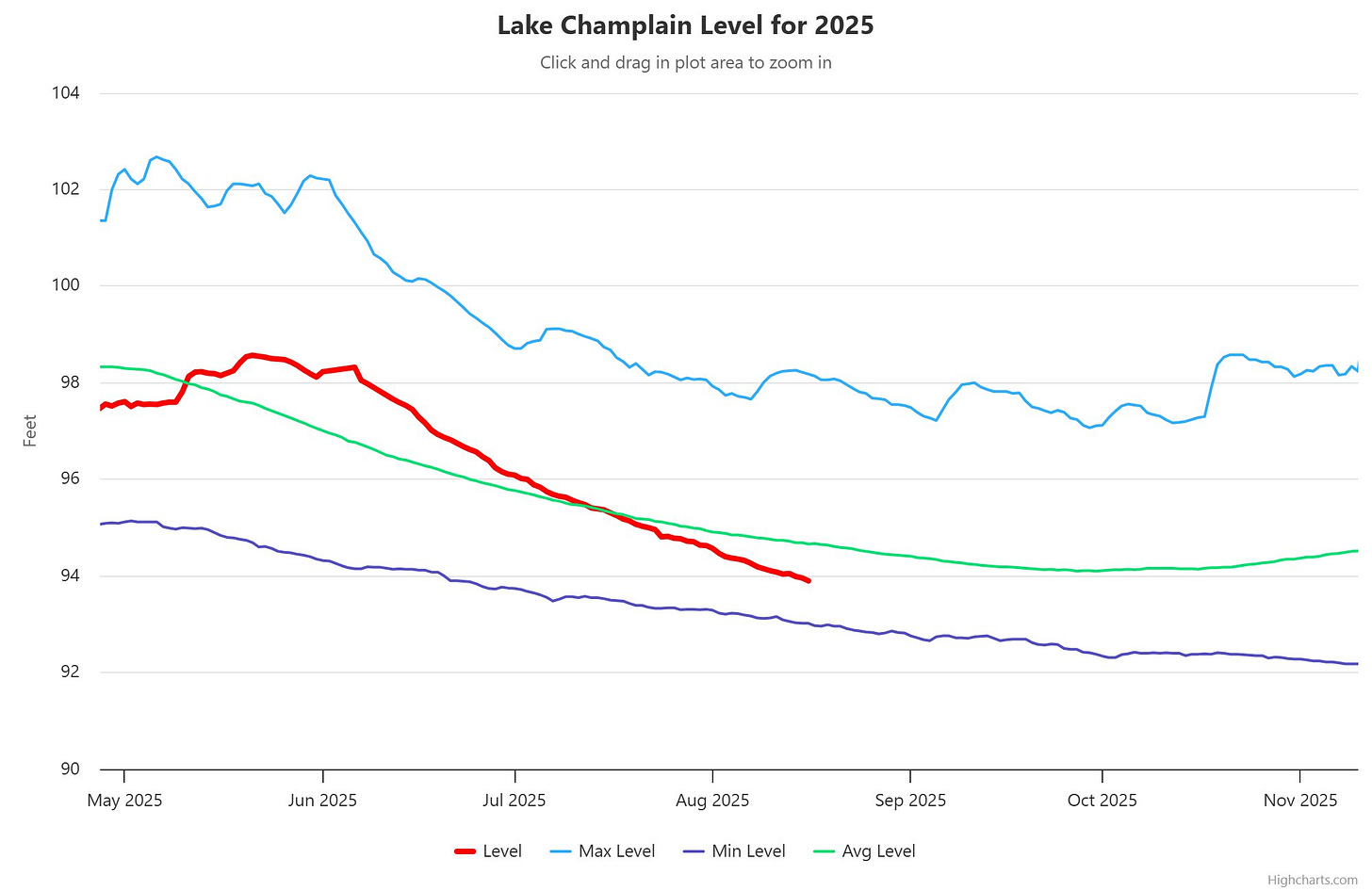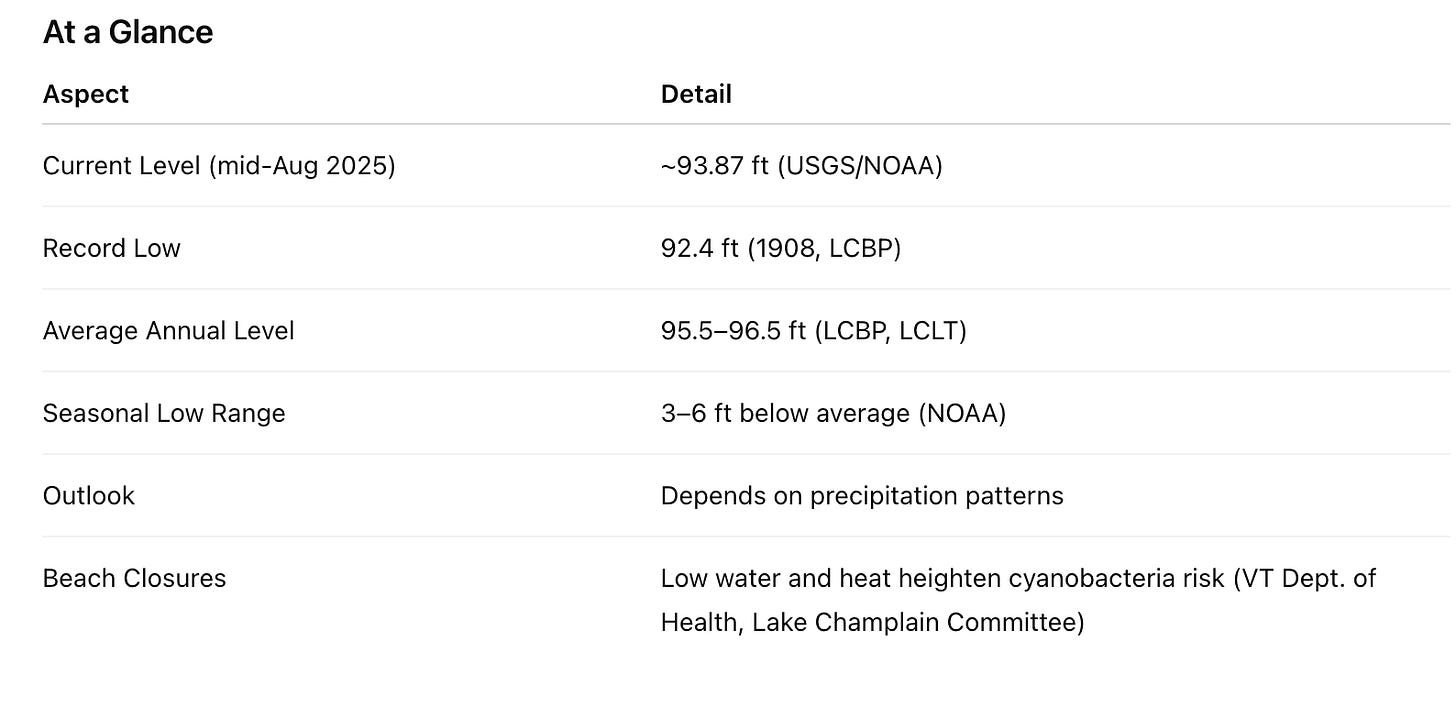Lake Champlain Water Levels: Mid-August Drop Raises Questions, But Still Above Historic Lows
One of the less obvious consequences of lower water levels is their effect on cyanobacteria, also called blue-green algae, which has closed multiple beaches this summer.
Why This Matters Now
Recreational boaters, shoreline residents, and environmental observers alike have noticed Lake Champlain’s shoreline pulling back this summer. The persistent dry conditions have caused the lake level to drop more quickly than usual, leading some to ask whether the region is facing a serious water shortage. While the lake is running low for mid-August, it remains well above record lows, and future rainfall will determine just how far levels will fall.
Current Conditions
As of August 17, 2025, the U.S. Geological Survey reported the lake’s level at 93.87 feet above sea level at Burlington, measured against the NAVD 1988 vertical datum. NOAA’s Burlington office confirmed a nearly identical figure of 93.88 feet in its daily recreational forecast.
Historical Context
According to the Lake Champlain Basin Program, the record low water level for the lake was 92.4 feet in 1908. Mid-August measurements between 93 and 94 feet have been seen in recent decades, meaning that while this summer’s drop is notable, it is not unprecedented.
On average, the lake sits closer to 95.5 to 96.5 feet over the course of a year, according to figures from both the Basin Program and the Lake Champlain Land Trust. That puts the current level about 1.5 to 2.5 feet below average.
Seasonal Trends
Lake Champlain typically dips to its lowest levels in late summer or early fall, after spring runoff has long passed and rainfall deficits accumulate. According to NOAA research, seasonal variation around the mean water level often ranges 3 to 6 feet in a typical year. This means lower water levels in August are part of the natural rhythm of the lake, though extended drought can push the lows further.
Impacts on Beach Closures and Cyanobacteria Blooms
One of the less obvious consequences of lower water levels is their effect on cyanobacteria, also called blue-green algae. According to the Vermont Department of Health, warm temperatures, low water circulation, and nutrient runoff from the watershed can create the perfect conditions for these harmful blooms. Lower water levels concentrate nutrients closer to the surface and reduce mixing, which can allow cyanobacteria to spread more quickly.
The result is often the closure of public beaches across Vermont and New York portions of the lake. Burlington’s North Beach and other popular swimming spots have faced periodic closures in past summers when blooms became widespread. According to the Lake Champlain Committee, bloom risk is highest in mid-to-late summer when water levels are already seasonally low and temperatures are warmest.
While cyanobacteria blooms are not directly caused by low water, the combination of shallower shoreline water, less dilution of pollutants, and stagnant conditions makes outbreaks more likely when the lake drops and the weather stays hot and dry. That means beachgoers may experience more advisories and closures if this year’s dry spell continues.
Outlook
How far the lake drops from here depends largely on weather in the coming weeks. According to the National Weather Service, if the dry pattern continues, levels could stay suppressed well into autumn. However, a shift toward wetter weather could stabilize the lake and prevent further decline
In Summary
Lake Champlain is low this August, but not alarmingly so when placed in historical context. According to long-term records, the current dip is within the normal range of late-summer lows. Still, the combination of low water, warm temperatures, and nutrient runoff could increase the risk of cyanobacteria blooms—meaning beachgoers may feel the impact of these numbers even more directly than boaters or shoreline residents.





